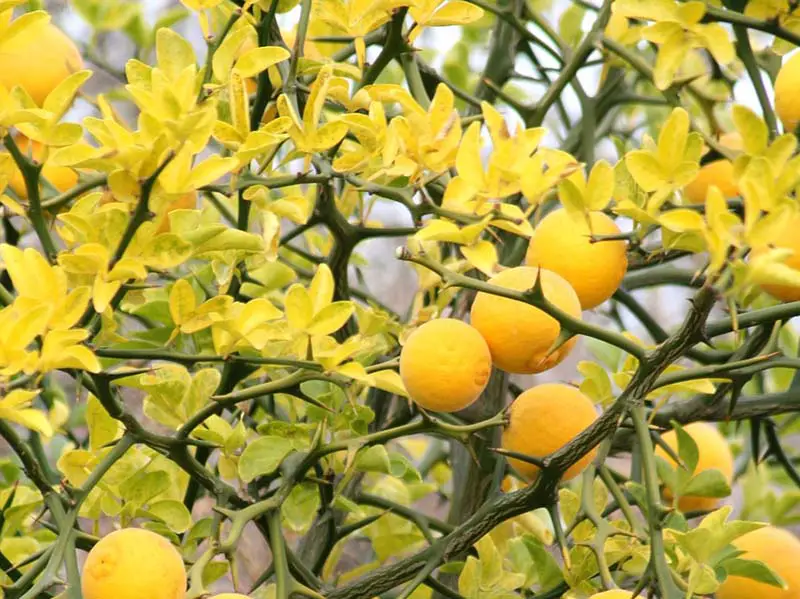
We may receive commissions from purchases made through links in this post, at no additional cost to you.
No matter how vigilant you are as a gardener, anything can happen. One day I wandered out into the garden and noticed that my Meyer lemon tree’s leaves were turning yellow. I thought I was doing everything correctly – watering, some fertilizer, full sun – and my tree had had a delicious crop of lemons the previous year. So what was going on?
Citrus trees are notorious for showing discoloration on the leaves the minute they are under stress. The question is, what is causing the stress? What exactly does it mean when a lemon tree’s leaves turn yellow? And, more importantly, how do you fix it?
The most common reasons for yellowing lemon tree leaves are overwatering and nutrient deficiencies, but inadequate sunlight, stressed roots, or certain pests and diseases can also cause yellowing leaves. The yellowing can be corrected by making adjustments to the care of the tree.
I’ve included photos and descriptions below of all kinds of yellowing lemon tree leaves. This is a common problem, but there are usually simple solutions. Read on to learn the different reasons a lemon tree’s leaves might turn yellow, and what to do about it.
What do yellowing lemon tree leaves mean?
When you notice yellow leaves on your lemon tree, pay close attention to the details. Where are the yellow leaves located? Are they only newer leaves, or is the older foliage losing its green color?
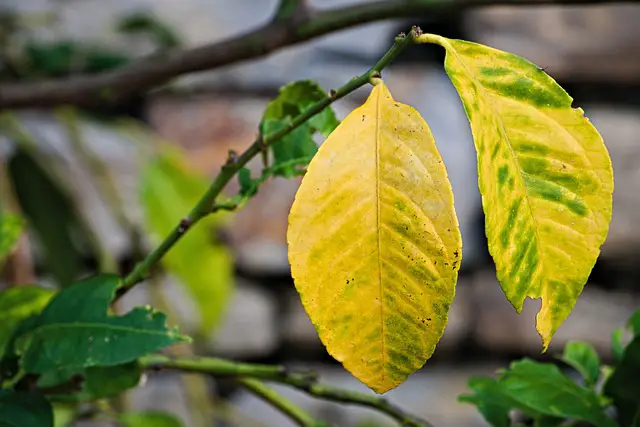
Also take note of what exactly the leaves look like. Are the leaves yellow all over, or more mottled? Are the veins still deep green with yellowing in between? Or are the leaves just yellow around the edges?
Each of the problems listed below will cause chlorosis (paling or yellowing of the foliage), but the pattern of the yellowing will be a bit different. It can sometimes be challenging to determine exactly what the cause of the chlorosis is, but this list will hopefully give you a good starting point for determining the root of the problem.
1. Overwatering
Water stress can cause yellowing lemon tree leaves – particularly overwatering. Too much soil moisture will keep the roots from absorbing what the plant needs for photosynthesis, causing chlorosis. Yellow leaves is often the first way to tell your lemon tree has been overwatered.
If the water stress continues, the yellow leaves will turn brown at the edges, droop, and then fall off. You may also notice a slight cupping of the leaves – another sign of stress.
Learn more: Watering Lemon Trees: How to Get It Just Right
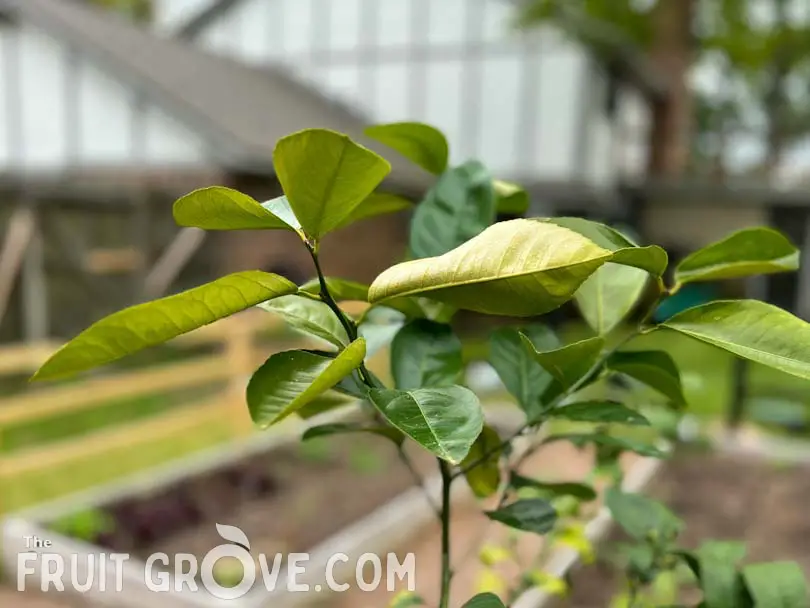
Overwatering quickly leads to root rot, which can be fatal for the tree. It’s common to accidentally overwater a lemon tree that’s been brought inside for the winter. Lemon trees slow their growth significantly over the winter by going partially dormant. The mild indoor environment combined with the tree’s slow growth means it needs far less water during the winter months.
It’s possible that there can be yellowing of the leaves due to drought stress, but it’s more common for an all-over paling or yellowing to be due to overwatering. The leaves of underwatered lemon trees usually stay green, but begin to dull in color and curl in severely at the edges.
Learn more: Is Your Citrus Tree Overwatered or Underwatered?
2. Nutrient Deficiencies
Lemon trees have voracious appetites and need a steady supply of fertilizer throughout the growing season – especially if grown in containers. A lack of nutrients can cause the leaves to turn yellow, although the exact pattern of the yellowing depends on the deficient nutrient.
I have since learned that Meyer lemons are particularly susceptible to nutrient deficiencies (hence my sad-looking foliage), but it’s common with any type of lemon. But consider this a helpful reminder to fertilize your Meyer lemons regularly. Mine bounced back once I adjusted my fertilizing regimen.
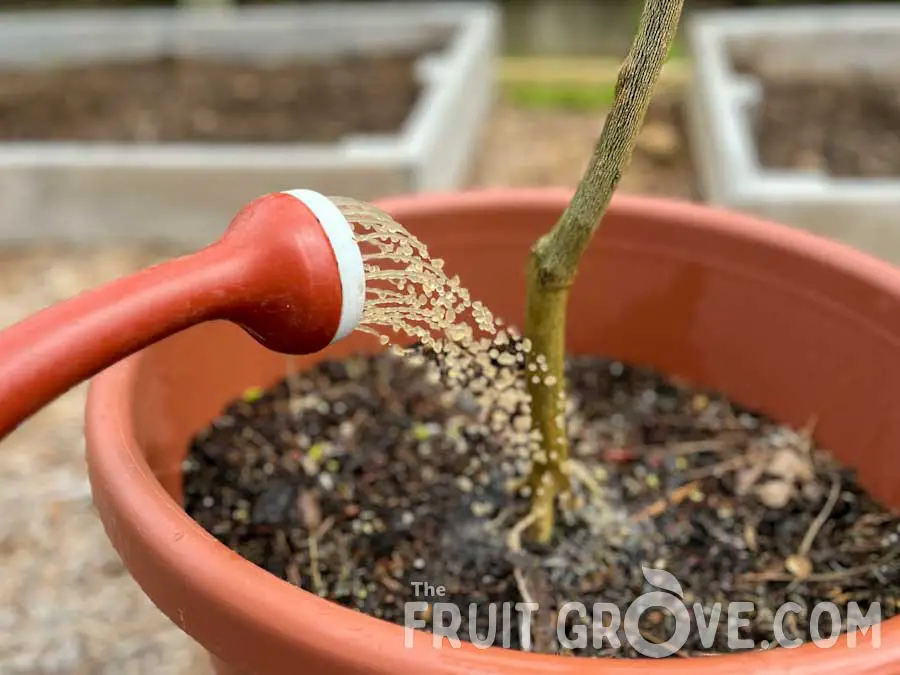
The way nutrients work together to support plant growth is a complicated thing. Nutrient deficiencies can be caused by a lack of availability, improper soil pH, imbalance with other nutrients (too much potassium in the soil, for instance, can keep roots from absorbing adequate magnesium), overwatering, or compacted soil.
The first step in solving these issues is overall good plant care – the right planting environment and soil, adequate sunlight, and regular watering and fertilizing. I’ve given suggestions for correcting these nutrient deficiencies below, but check out this article for details about feeding lemon trees: Fertilizing Potted Lemon Trees: Everything You NEED to Know.
And here’s a post all about citrus potting soil: The Best DIY Citrus Potting Mix Recipe (Plus 5 Brands to Try).
Note – Use these photos and descriptions as a guide when figuring out what your plant may be lacking. I’ve linked to helpful outside information where I can. Even experts aren’t always clear on the exact nutrient deficiency until they test the plant, so when in doubt, consult your local extension service.
Nitrogen Deficiency in Lemon Trees
The most noticeable thing about a nitrogen-deficient lemon tree is that the chlorosis will probably be visible over the entire plant. The older leaves will turn pale yellow-green first, then little by little the yellowing will spread over the whole tree. The leaves will become uniformly pale, then more yellow, with no discernible pattern. Eventually, the leaves will fall off the tree from bottom to top.
Occasionally, a nitrogen deficiency can appear on leaves as yellow ribbing on an otherwise green leaf, or as an overall yellow-bronze appearance. Read more about nitrogen deficiency from the University of Florida (including more photo examples) here.
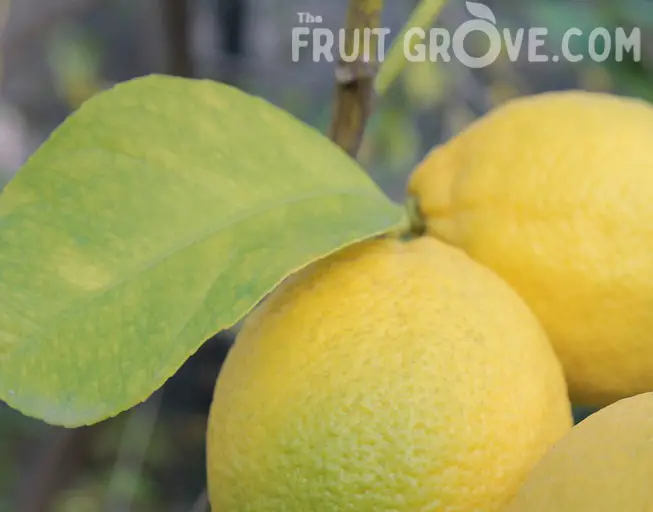
A nitrogen deficiency may be more noticeable in the winter and early spring. Lemon trees have more trouble absorbing available nitrogen when the soil is cold and wet. Chronic nitrogen deficiency may also be caused by overwatering, which leads to nutrients leaching out of the soil. It could also be a symptom of root rot or overly compacted soil.
To correct the problem, feed the lemon tree with a nitrogen-heavy fertilizer (look for a higher first NPK number on the fertilizer package), such as this one. You can also add blood meal, an organic source of nitrogen, directly to the soil. Always take care to follow package instructions for the exact amounts to use.
Potassium Deficiency in Lemon Trees
Potassium deficiency first appears as yellow blotches on the edges of the leaves. Then the yellowing will spread, and small brown necrotic spots will start to show. The leaves may also be slightly wavy or corkscrewed, or may turn down at the tip. The resulting fruits will also be smoother and much smaller than normal (source).
Related: Lemon Tree Leaves Curling? Here’s What to Do About It
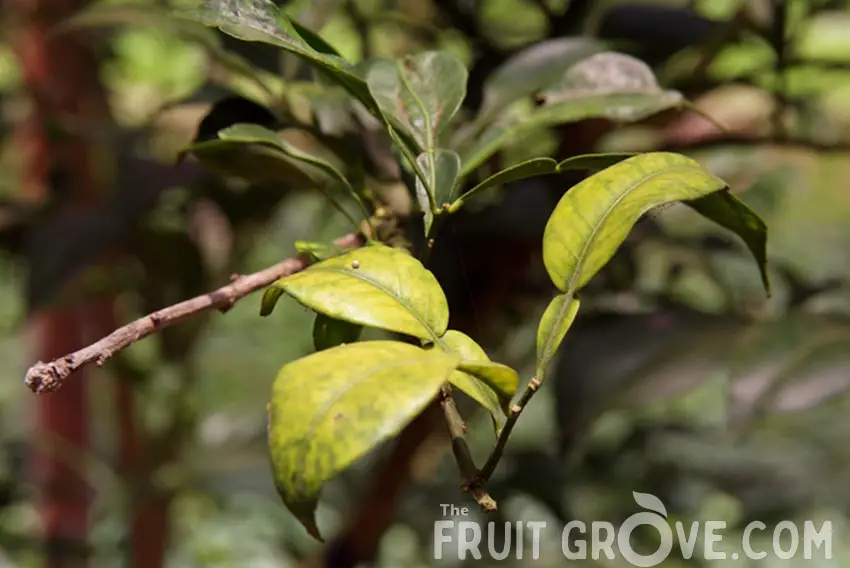
A potassium deficiency can develop in soils with a higher pH (alkaline). A tree that has been over-fertilized with nitrogen may also have trouble absorbing enough potassium to keep up with fruit production.
Potassium, along with nitrogen and magnesium, is what’s called a mobile nutrient – meaning the plant can pull potassium from older leaves to use for the development of new leaves. As a result, you may notice discoloration in older leaves first.
It’s essential to provide lemon trees with adequate potassium because it is important for developing the size, flavor, and color of the fruit (you want your lemons to be large, yellow, and juicy!). Potassium can also help protect the plant from injuries due to cold, drought, or overwatering.
Correct a potassium deficiency by applying a potassium-heavy fertilizer (the third NPK number). My go-to fertilizer for lemon trees is this one, because it contains a good amount of both nitrogen and potassium, as well as other micronutrients. You can also apply potassium chloride (muriate of potash) or potassium sulfate to the soil. Again, follow the instructions on the label.
Magnesium
Magnesium is a very mobile nutrient, so older leaves will show symptoms of deficiencies first. You’ll first notice yellow blotches near the center or base of the leaf, then the blotches will enlarge until the entire leaf is yellow except for a V-shaped area around the midrib (the line down the center of a leaf) (source).
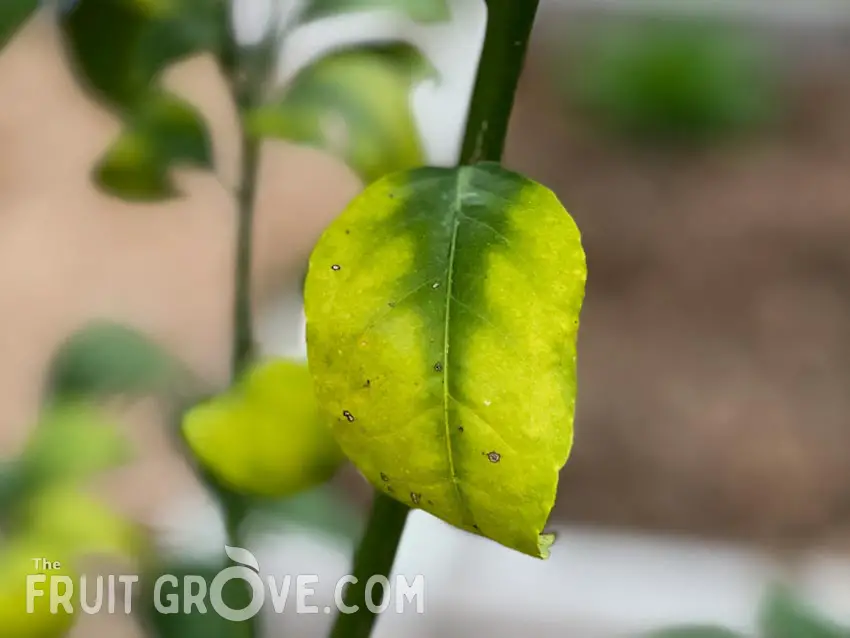
Branches that bore a heavy crop of fruit the previous year are the most likely to show a lack of magnesium. This deficiency can be a particular problem in acidic, sandy soils. If left untreated, the tree may be more susceptible to cold injury, and there will be a reduction in fruit quality and quantity.
To correct a magnesium deficiency, use dolomite lime (a natural mineral fertilizer) to add calcium and magnesium and raise the pH. You can also use Epsom salts (magnesium sulfate), either as a side dressing (sprinkled onto the soil and then watered in) or as a solution of about 1 tablespoon per gallon of water, applied to the soil or as a foliar spray.
Note – If you use Epsom salt as a leaf spray, be very careful. Only apply in the early morning or evening to avoid leaf scorch. It’s also important, despite much old-fashioned gardening advice, to only apply Epsom salt if there is evidence of a magnesium deficiency. Excessive magnesium will cause far more harm than good. Here’s an interesting article from Washington State University that debunks a lot of Epsom salt myths.
Iron, Zinc, or Manganese Deficiency in Lemon Trees
Deficiencies of these micronutrients, in particular, can be challenging to tell apart – even for experts. In commercial citrus farming, growers would perform soil and plant tissue tests to determine precisely what nutrients may be lacking. I don’t know about you, but I don’t have the capability of doing that in my own little backyard Fruit Grove.
Iron, manganese, and zinc are all immobile nutrients, so symptoms will first show on new growth. Lemon trees can typically absorb what they need from the soil, but they may have trouble if the pH is too high. An incorrect pH can prohibit roots from being able to uptake available nutrients.
I’ve included descriptions of the leaf symptoms for iron, manganese, and zinc nutrient deficiencies as well as links to learn more about them. The good news is, lemon trees only need these elements in trace amounts. You can see what micronutrients are present in a fertilizer by checking the back of the label.
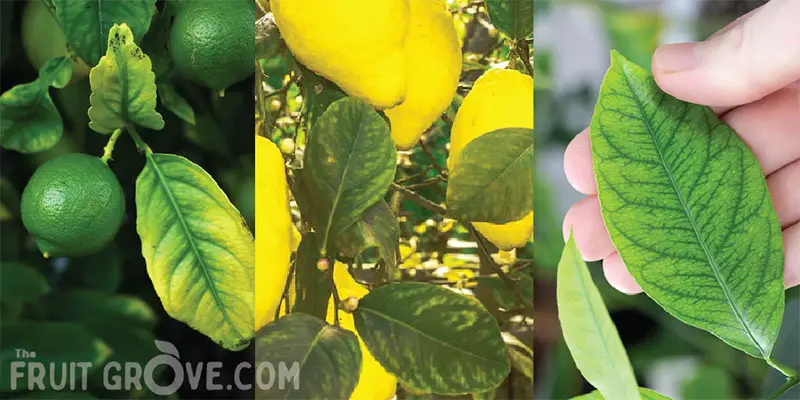
An iron deficiency is characterized by light yellow-green leaves with visible dark green veining, similar to the picture on the right, above. In bad cases, the leaves are thinner and the tree will die back at the top. Overwatering, poor drainage, cool soil temperatures, and excessive salt in the soil can lead to iron deficiency (source).
To correct an iron deficiency, first check the soil pH with a meter or testing kit. Lemon trees prefer acidic soil with a pH of 5.5-6.5. To lower soil pH (make it more acidic), apply a sulfur-based soil acidifier. To raise it (more alkaline), use garden lime. If the pH isn’t the problem, you can also apply chelated iron to the soil, according to the package instructions.
Zinc deficiency will show as leaves with yellow patches between dark green veining. The veins of a zinc-deficient leaf will be broader than one lacking iron (similar to picture on the left, above). It’s a very common deficiency and can happen in both acidic and alkaline soils.
A zinc deficiency can occur when far too much potassium or nitrogen have been applied to the tree, such as with excessive poultry manure, for example. In severe cases, the fruit will be small and coarse, and leaves may be small and pointed (source.)
Zinc deficiency is treated with a foliar spray. Apply zinc sulfate, oxide, or nitrate on young growth as described on the label. (Don’t forget to check the pH of your soil first).
Nutrient deficiencies often happen because of incorrect soil pH. Lemon trees prefer acidic soil with a pH of 5.5-6.5. Before correcting the deficiency, double check the pH of your soil!
A manganese deficiency shows as yellow leaves with green veins, similar to iron and zinc. However, the leaf appears more mottled all over, especially from a distance (similar to the middle picture, above). The pattern is less distinct on young leaves, and worsens as the leaf matures.
Manganese deficiency can happen in either alkaline or acidic soil. To correct a manganese deficiency in acidic soil, use a fertilizer containing manganese. In alkaline soils, apply a foliar manganese spray directly to the leaves (source).
3. Growing Conditions
Although overwatering and lack of nutrients are the most common reasons for yellow lemon tree leaves, yellowing can also be caused by the growing conditions of the plant. In addition to cultural practices such as watering, fertilizing, and soil health, look at the planting environment to determine the cause of yellow leaves.
Lack of Sun
Lemon trees, like most fruit trees, need at least 6 to 8 hours of full sunlight a day to thrive. This can be especially challenging if the tree lives indoors for most of the year. But if your lemon tree is in a container, you have the advantage of being able to move it around to find the ideal spot.
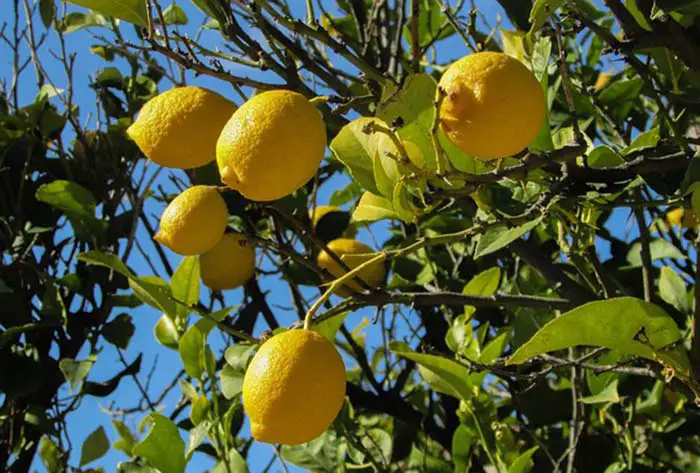
If your lemon tree looks a little lackluster, try moving it to a sunnier location in your garden. Or, if it’s indoors, place it in front of a bright south-facing window. A lack of light may be the reason for pale foliage.
Rootbound
Lemon trees, particularly dwarf varieties, grow very well in containers. I have two potted lemon trees (in addition to other citrus trees) – the Improved Meyer lemon and a Variegated Pink lemon tree. But as the tree grows its roots can run out of space and become potbound.
A lemon tree that is pale and stressed-looking may need to be moved to a bigger pot. As the roots grow, there are fewer available nutrients in the soil to support the growing tree. Roots need space and air, even within a pot.
Related: Fertilizing Potted Lemon Trees: Everything you NEED to Know
Transplant a struggling lemon tree to a larger container. You can even trim the rootball somewhat (about 25%) to keep its size relative to the pot. Aim to have about 1-2 inches of space between the rootball and the side of the container.
Competition with Weeds
For lemon trees planted in the ground, keep excessive weeds away. It may not seem like such a big deal, but weeds growing close by can compete for nutrients with the tree. Keep weeds away to allow the tree’s roots space to spread and absorb water and minerals from the soil. A layer of mulch can help keep weeds from returning, and will help regulate soil moisture and temperature as well.
4. Cold Temperatures
A sudden drop in temperature can make lemon leaves look patchy and yellow. As with everything else on this list, the chlorosis is a sign of stress. Cold weather inhibits the roots from effectively absorbing nutrients, causing yellowing.
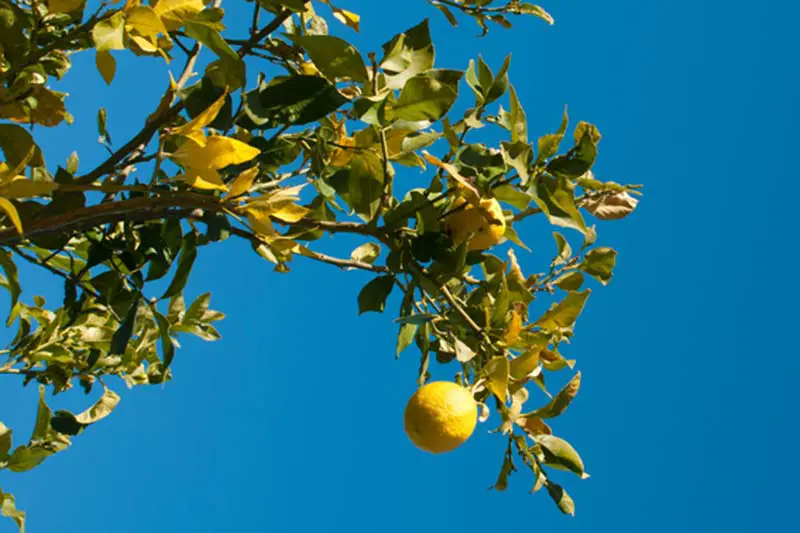
If the cold is relatively mild, the tree will recover. A deeper freeze may cause some dieback of the tree, however. Signs of more severe cold damage include leaves that have darker, wet-looking patches, or that turn brown right away. If a lemon tree’s leaves turn brown but still cling to a branch, then it is likely that the branch (or possibly the whole tree) is dead.
It’s actually a good sign if dead or damaged leaves fall off of a branch. In many cases, the defoliated branch is still alive and will produce new growth once the tree recovers and the weather warms.
An advantage to growing potted lemon trees is the ability to easily protect them from the cold. Simply bring the tree indoors, or into a protected shed or garage. Then as the weather starts to warm in spring, gradually reintroduce the tree to the outdoors.
If you notice yellowing leaves after a cold snap, resist fertilizing the tree. Fertilizing may cause the tree to produce new growth, and the tender young foliage will be more susceptible to frost damage. Wait until spring to feed the lemon tree.
5. Diseases and Pests
Although malnutrition and overwatering are the main causes for yellowing lemon tree leaves, some pests and diseases can also cause leaf discoloration. Read on to learn about a few diseases and insects that can cause chlorosis.
Citrus Tristeza Virus
A major symptom of this damaging virus complex is pale greenish-yellow foliage. There are multiple strains of this virus, but they are all typically spread by aphids (source).
The best management for Tristeza is prevention. Certain rootstock is more susceptible to this virus, so choose a tree that is grafted onto resistant rootstock. Take steps to manage or prevent aphid infestation, such as pruning affected growth, spraying with a stream of water (with or without soap), setting baits for ants (which protect aphids), and attracting beneficial predatory insects.
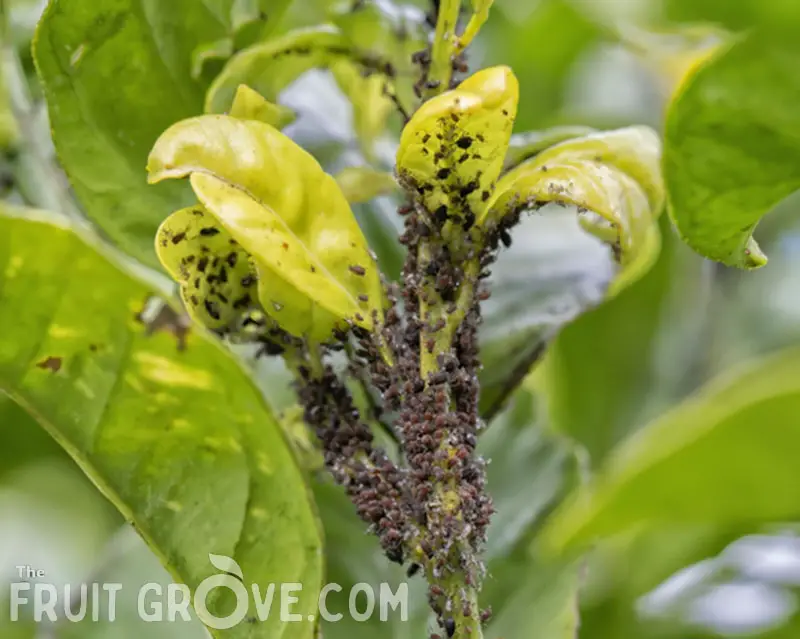
Huanglongbing (HLB)
This serious citrus disease is also called citrus greening or yellow dragon disease. It’s a bacterial infection spread primarily by citrus psyllids (a tiny, aphid-sized insect), but it can also spread through grafting and contact with infected plant material (source).
Trees infected with HLB will intially show leaves with yellow splotches, then eventually yellow and brown discoloration primarily on one side only of the leaf. Fruit from infected trees will be yellow at the stem end but still green at the navel. HLB also causes stunted growth and premature fruit drop. Visit this site to see pictures of what HLB infected leaves look like.
Unfortunately, there is no cure for HLB. The best way to treat it is to remove and dispose of infected trees. Don’t reuse potting soil from the tree, and don’t replant a new lemon tree in the same spot.
Citrus Variegated Chlorosis (CVC)
This is a bacterial disease that causes yellowing spots between leaf veins, similar to zinc deficiency. There will also be brown lesions on the underside of the leaf. This disease is spread through grafting and by sharpshooter insects.
In most locations, CVC is not a major problem. For California residents, see this article from the California Department of Food and Agriculture for information on how to recognize and prevent CVC.
Psorosis
Citrus psorosis is caused by a virus that mostly affects orange and grapefruit trees, but lemon trees can also be susceptible. The primary symptom is scaly, flaking bark, but the leaves can also develop small yellow spots between the veins (source).
Psorosis is mainly transmitted through non-disinfected pruning tools. It is rarely fatal to lemon trees, but it will make the trees far less productive. In order to have the best crop possible, it’s best to replace psorosis-infected lemon trees.

